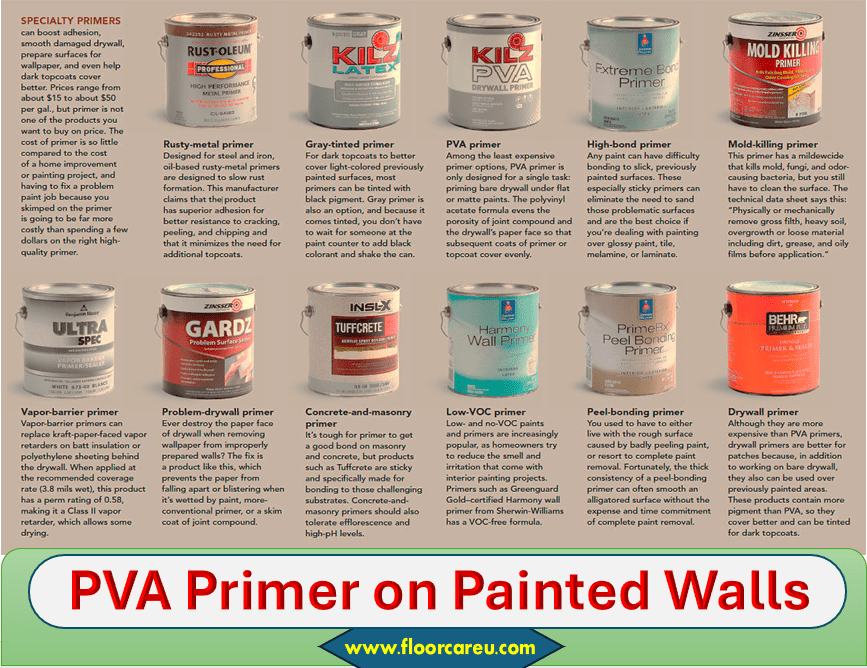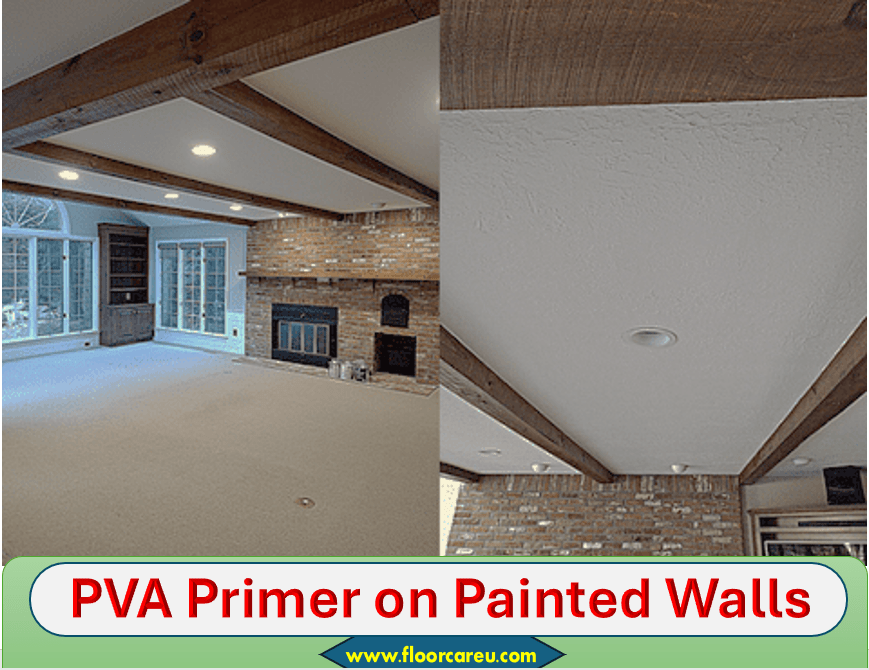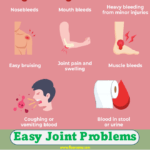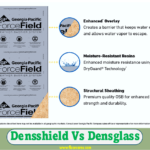PVA Primer on Painted Walls: Applying PVA Primer on painted walls is not recommended as it is designed to adhere to bare surfaces only. Despite this, PVA Primer is ideal for sealing porous surfaces and can be used on bare, previously painted drywall or plaster easily, ensuring proper adhesion for the next coat of paint.
Using PVA over existing paint may not provide the desired results and could lead to issues such as peeling or flaking. To achieve a smooth and long-lasting finish, it’s crucial to prepare the painted walls properly before applying PVA Primer.
Understanding the differences between PVA Primer and regular primer can help you decide on the appropriate primer for your specific painting project.

The Benefits Of Using PVA Primer
Primers like PVA act as an adhesive layer, promoting better paint adhesion on various surfaces. PVA primers seal porous surfaces, ensuring a smooth and uniform finish for your topcoat.
Common Misconceptions
Several misconceptions about using PVA primer on painted walls need to be addressed. Let’s debunk some common myths and misunderstandings about using PVA primer on painted surfaces.
Incompatibility With Paint
It’s a common misconception that PVA primer cannot be used on painted walls. Contrary to this belief, PVA primer can effectively bond to existing paint, facilitating adhesion for the new coat of paint. However, it’s important to note that any flaking paint should be removed, and the PVA may need to be diluted with water for optimal results.
Limitations
There’s a common misconception that PVA primer has limited applicability and is suitable only for bare drywall under flat or matte paints. While it is true that PVA primer is designed primarily for priming bare drywall, it can also be used on previously painted surfaces, drywall, and plaster. Its exceptional flow and leveling properties allow easy application through brushing, rolling, or spraying.
How To Properly Apply PVA Primer
PVA primer is essential in painting projects, especially when painting over already-painted walls. Applying PVA primer provides a stable base for the new coat of paint, ensuring better adhesion and a smoother finish. However, it is crucial to apply PVA primer properly to achieve the desired results. This section will discuss the surface preparation and application techniques for applying PVA primer on painted walls.
Surface Preparation
Before applying PVA primer, it is essential to prepare the painted walls properly. Follow these steps for surface preparation:
- Inspect the painted walls for any loose or flaking paint. Scrape off any loose particles, and if necessary, sand the surface lightly to create a smoother base.
- Clean the walls thoroughly to remove any dirt, grease, or dust. A mild detergent or TSP (trisodium phosphate) solution ensures a clean surface.
- Repair any cracks, holes, or imperfections in the painted walls using a suitable spackling compound or putty. Allow the repairs to dry completely before moving forward.
- Tape off any areas you want to protect, such as trim, windows, or electrical outlets.
Application Techniques
Now that the surface is properly prepared applying the PVA primer is time. Here are some application techniques to follow:
- Stir the PVA primer thoroughly before use to ensure a consistent product.
- Choose the appropriate application method for your project, whether brushing, rolling, or spraying. Whichever method you choose, use even strokes for a consistent application.
- If using a brush, start by cutting in around the edges of the walls and any tight corners. Then, fill in the larger areas using long, smooth strokes.
- Use a medium nap roller cover to apply the PVA primer evenly for rolling. Start from the top of the wall and work down in small sections, overlapping each stroke slightly.
- Follow the manufacturer’s instructions for proper spraying techniques and equipment if spraying. Ensure proper ventilation and use protective equipment, such as a respirator and goggles.
- Apply a thin and even coat of PVA primer, avoiding excessive buildup or drips.
- Allow the primer to dry completely per the manufacturer’s instructions before applying the topcoat of paint.
By following these surface preparation and application techniques, you can ensure a successful application of PVA primer on painted walls. Properly applying the primer will enhance the overall adhesion and durability of the paint, resulting in a beautifully finished project.
Choosing The Right Primer For Different Surfaces
Understanding the differences between PVA primer and regular primer is essential when choosing the right primer for different surfaces.
PVA primer, short for polyvinyl acetate primer, is specifically designed for priming bare drywall under flat or matte paints. It evens the porosity of the joint compound and the drywall’s paper face, ensuring a smooth and uniform surface for paint application.
On the other hand, regular primer, also known as multi-surface primer, is a more versatile option that can be used on various surfaces such as wood, metal, and previously painted walls. It provides better adhesion and helps to seal porous surfaces, ensuring that the topcoat of paint adheres properly.
While both PVA primer and regular primer can be used on painted walls, some considerations must be made.
- PVA primer should not be applied over existing paint. Its purpose is to prime bare surfaces, not to bond to the paint on the walls. If you attempt to use PVA primer on painted walls, it may not adhere properly, leading to peeling or flaking.
- On the other hand, regular primer can be used on painted walls. It helps to provide better adhesion for the new coat of paint, ensuring a long-lasting and professional finish. However, if the existing paint is flaking or peeling, removing it before applying the primer is important.
When selecting a primer for painted walls, consider the existing paint’s condition and the type of finish you want to achieve. Regular primer is a safer choice if you’re unsure about the condition of the painted surface, while PVA primer is ideal for new drywall or when you’re painting with flat or matte paints.
Comparing Various Brands
When comparing various brands for PVA primer on painted walls, Valspar Pro, Dutch Boy, and Kilz PVA are reliable options. Each brand offers quality interior latex PVA primer that effectively seals porous surfaces and prepares them for a fresh coat of paint.
Valspar Pva Primer
When choosing a reliable PVA primer, Valspar is a top contender. With its professional quality and interior latex PVA primer, Valspar offers a reliable option for sealing porous surfaces. The primer effectively prepares surfaces for architectural topcoats, providing great flow and leveling properties for easy application. The Valspar Pro Interior PVA Water-Based Wall and Ceiling Primer is another affordable and effective option for paint bonding.
Kilz Drywall Primer
KILZ also offers a range of PVA primers tailored to different needs. The KILZ PVA Drywall Primer is a professional interior primer that efficiently primes bare or previously painted drywall and plaster surfaces. While it effectively bonds to existing paint, it ensures a strong foundation for the new coat of paint, making it a reliable choice for painting projects.

Frequently Asked Questions Of PVA Primer On Painted Walls
Can You Put PVA Primer Over the Existing Paint?
Yes, you can use PVA primer over existing paint. It effectively seals porous surfaces for a new coat to bond properly.
Can You Use Kilz Pva Primer On Painted Walls Before?
It would help if you didn’t use Kilz PVA primer on painted walls. The PVA will only bond to the existing paint, so it’s not advisable.
What’s The Difference Between Pva Primer And Regular Primer?
PVA primer is specifically designed for priming bare drywall under flat or matte paints, while regular primer can be used on various surfaces. PVA primer evens the porosity of joint compound and drywall paper, ensuring that subsequent coats of paint cover evenly.
Can I Use Drywall Primer On Painted Walls?
Yes, you can use PVA primer on painted walls to effectively help the new coat of paint bond. Ensure any flaking paint is removed, and consider diluting the PVA with water before application. PVA primer is suitable for bare or previously painted surfaces and can be applied easily.
Can You Use PVA Primer Over Existing Paint?
Yes, our PVA primer effectively seals porous surfaces, preparing them for any architectural topcoat. It can be used over bare or previously painted drywall, plaster, and previously painted surfaces.
Can You Use Kilz Pva Primer On Painted Walls Before?
No, using PVA over a painted substrate is not advisable. The PVA will bond to the paint you already have on the walls and help the new coat of paint bond, but any flaking paint should be removed.
Conclusion
Choosing the right primer for your painted walls ensures a smooth and durable finish. PVA primer can effectively seal porous surfaces and prepare them for a fresh coat of paint, providing great flow and leveling properties. However, it’s important to note that PVA primer is best suited for unpainted drywall and may not be suitable for previously painted surfaces.
Understanding the difference between PVA primer and regular primer is crucial in achieving the desired results for your painting project.


